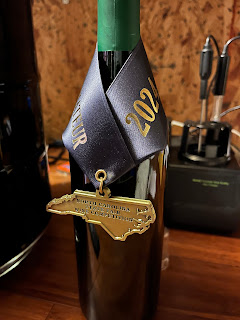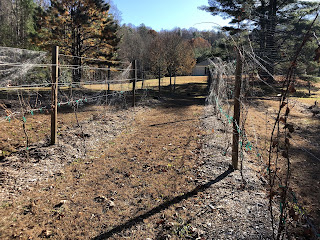Three Row Vineyard
Just a few grape vines growing in a backyard.
Saturday, February 15, 2025
2024 Awards
Sunday, December 18, 2022
2021/2022 vintage results and assessment.
2021 survived an early frost that devastated some local wineries. But we didn’t escape without a scratch. Later in the year, wasps went after a good amount of the grapes which caused damage and some fermentation problems. The wine had heavy levels of H2S as we didn’t add enough yeast nutrient. So how this wine turned out over a year later after adding Reduless and Noblesse to remedy is interesting. Clearly this didn’t resolve all the issues. But after a couple hours of decanting the wine was very drinkable much to my surprise. There’s still a bit a mustiness to this wine but maybe after time in the bottle … who knows.
2022 went off without a hitch. Netting was installed to protect grapes against wasps and birds. Rains were projected to come in early; every winery was picking a few weeks earlier than they would have liked to. But after adding some sugar, ph came in okay. We used Muse yeast to prevent H2S with a lower ferment temp below 77 degrees. Viognier fermented temperature controlled at around 60 degrees. I bought a Flextank to age our reds and blended 70% Cabernet Sauvignon, 15% Cabernet Franc and 15% Merlot. This is my first time attempting a blend so I defer to a “boiler plate” recipe for a Bordeaux style.
Now we are at a point where 30 gallons are coming and and more on the way next year. I opened up a few bottles of great wines in the meantime while we wait for 2022 to age in the Flextank with French oak for 12 months.
Sunday, August 15, 2021
Wednesday, May 12, 2021
Good books for grape growing / winemaking
I’ve read a few books on growing grapes and winemaking. Here are a few I’d recommended in no particular order:
Tuesday, May 11, 2021
2020 wine assessment and 2021 plans
Monday, January 27, 2020
Winter 2020
Tuesday, October 22, 2019
Fall/Winter 2019
The purpose of this is prevent any reaction in the wine from occurring between tartaric acid .and potassium. After fermentation, but prior to bottling, cold stability (chilling the wine near freezing) is conducted to prevent the tartaric salt crystals from forming after bottling that can shift the ph. Since there's only a few gallons of wine this year, they fit easily in a fridge. After a couple of months, the wine will be racked and stored at 55 degrees for six months or more before bottling.
I did not add malolactic culture to the wine so it will have to happen naturally if it happens at all.
Mulch is also added to the vineyard rows to limit weed growth.
Plans for next year: an additional row of cabernet sauvignon and merlot are ordered for planting next spring. This will effectively double the output of red wine. Viognier ripened nicely this year but has been so slow to establish that I'm leaving it to one row.

























